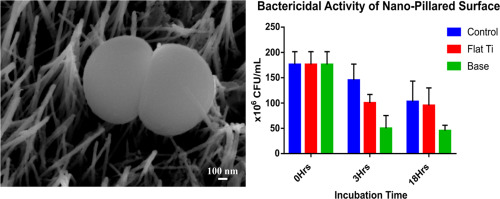Journal of the Mechanical Behavior of Biomedical Materials ( IF 3.3 ) Pub Date : 2018-02-12 , DOI: 10.1016/j.jmbbm.2018.02.011 Alka Jaggessar , Asha Mathew , Hongxia Wang , Tuquabo Tesfamichael , Cheng Yan , Prasad KDV Yarlagadda

|
The application of orthopaedic implants is associated with risks of bacterial infection and long-term antibiotic therapy. This problem has led to the study of implants with nano-textured surfaces as a method of inhibiting bacterial adhesion and reducing implant failure due to infection. In this research, various nano-textured surfaces of TiO2 were synthesised using hydrothermal synthesis, by varying NaOH concentration, reaction time and reaction temperature. Their correlations to mechanical, morphological, bactericidal and osteogenic properties of the surfaces were investigated. It was found that high alkaline concentrations produced large nanowire mesh arrays, while short reaction time and low temperature produced comparatively smaller arrays. The highly dense morphology formed at higher NaOH concentrations has resulted in high elastic modulus and hardness values, compared to surfaces produced at lower NaOH concentrations. Viability tests of the TiO2 nanowire array against gram-positive Staphylococcus aureus cells showed a bactericidal efficiency of 54% and 33% after 3 and 18 h, respectively. This nano-textured surface produces an osteoblast cellular metabolic activity of 71% after 24 h, compared to 67% when exposed to a flat Ti control surface. This preliminary work demonstrates an excellent outcome in producing bactericidal surfaces that promoted metabolic activity of human osteoblast cells for potential use in orthopaedic implants.
中文翻译:

水热合成TiO 2纳米线阵列的机械,杀菌和成骨行为
骨科植入物的应用与细菌感染和长期抗生素治疗的风险有关。这个问题导致了对具有纳米纹理表面的植入物的研究,该植入物是抑制细菌粘附并减少由于感染引起的植入物失效的方法。在这项研究中,TiO 2的各种纳米纹理表面通过水热合成,通过改变NaOH的浓度,反应时间和反应温度来合成。研究了它们与表面的机械,形态,杀菌和成骨特性的相关性。发现高碱浓度产生较大的纳米线网状阵列,而短的反应时间和低温产生相对较小的阵列。与在较低的NaOH浓度下产生的表面相比,在较高的NaOH浓度下形成的高密度形态导致了较高的弹性模量和硬度值。TiO 2纳米线阵列对革兰氏阳性金黄色葡萄球菌的生存力测试在3小时和18小时后,细胞显示出杀菌效率分别为54%和33%。该纳米结构化表面在24小时后产生的成骨细胞细胞代谢活性为71%,而暴露于平坦的Ti对照表面则为67%。这项初步工作表明,在生产可促进人成骨细胞新陈代谢活性的杀菌表面方面,其潜在成果可在整形外科植入物中使用。











































 京公网安备 11010802027423号
京公网安备 11010802027423号